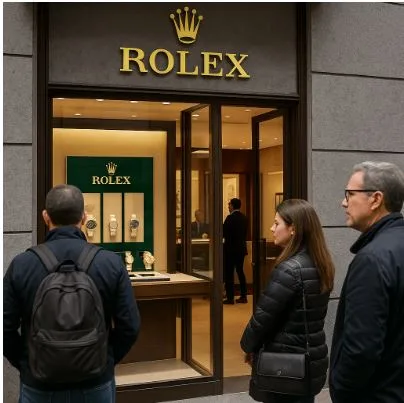Rolex prices 2020–2025: value resilience, risks, and buyer playbook
Hype to reset to balance: why Rolex resale became a barometer
Walk into an authorized dealer and the dynamic is obvious: long lists, thin allocations, and buyers who cite reference numbers from memory. Pre-owned prices reflect that pressure. Steel sports lines—Submariner, Daytona, GMT-Master II, Explorer—anchor liquidity, while the Datejust keeps turnover steady because it fits office wear. Over five years, many buyers treated a Rolex as a wearable store of value rather than a gadget. That view persists when a watch still looks right after hundreds of daily commutes. Liquidity follows repeat wear.
From surge to comedown to plateau: the 2020–2025 arc
Think in three acts. 2020 to early 2022 was a sprint as scarce AD stock met lockdown savings and social buzz. Mid-2022 brought rapid repricing when rates rose and speculative bids faded. Through 2023 and into 2025 the slide slowed; by early 2025, bids for core models ticked up and spreads tightened. The same rhythm showed up in Europe—cross-border buying softened yet continued. This five-year frame of hype, correction, and stabilization sets the baseline for any pricing conversation.
Which references held up—and what that tells you about demand depth
Several models proved resilient. Datejust 126334 moves reliably thanks to wearable case diameters and broad appeal. Day-Date 228238 in yellow gold kept momentum where classic design meets practical sizing. In contrast, Sea-Dweller 126600 and the “Sprite” GMT-Master II 126720 showed more swing. Platinum Daytona 116506 barely shifts in percentage terms but sits at a high absolute price; steel Daytona 116500 variants lean heavily on condition and completeness. Prefer a structured German read? Detailed German analysis of Rolex prices and the secondary market outlines the same trajectory; treat it as a framework and then validate with recent comparable sales.
Four levers that actually move prices—supply, story, spotlight, sellability
① Supply. Rolex publishes no model caps, yet allocation behaves like a soft quota, especially for steel sports. Limited flow pushes real buyers into pre-owned channels and supports clean examples.
② Story. Designs evolve slowly while movements improve; a five-year-old Submariner still suits a suit or a hoodie. This continuity reduces decision risk.
③ Spotlight. Ambassadors matter, but organic moments—podiums, films, airports—sustain attention without constant campaigns.
④ Sellability. Condition, set completeness, and service history decide time-to-cash. Sharp cases and original parts narrow the gap between ask and paid. Over-polish, swapped inserts, or mismatched hands widen it. Practical tip: shoot straight-on lug-to-lug photos and list bracelet stretch in millimetres to pre-empt doubts.
Rates, duties, headlines: do macro shocks really dent Rolex?
Macro shifts alter velocity more than underlying demand. Rate hikes in 2022–2023 raised the cost of cash and cooled flipping. Policy and trade headlines in 2024–2025 nudged stickers and confidence. Still, by mid-2025 bids for core references looked firmer and forced selling eased. Currency also matters: a stronger USD relative to EUR slows cross-border arbitrage; near parity speeds it up. In practice, buyers now separate references that kept falling from those that dipped, flattened, and found a workable floor. Use that split when setting targets.
Where value lasted: a 2025 map you can act on
- Want long-run liquidity? Submariner, GMT-Master II, and Daytona remain the dependable trio. Choose crisp cases over “full set but heavily polished.”
- Prefer low-drama ownership? Explorer I/II and Datejust 36/41 often trade in tighter bands and suit a wide range of wrist circumference.
- Chasing the pop? Bright-dial Oyster Perpetuals spiked in 2021–2022, then retraced in 2023–2024—buy to keep, not to flip.
- Precious metal? White-gold sports models age discreetly and can carry smaller premiums than yellow-gold, but factor in service and scratch visibility.
- When to act? Inventory swells around gifting seasons and big fairs; mid-cycle months reward documented offers with clear macro photos.
Rolex 2020–2025 secondary-market timeline
| Phase | Period | Rolex trend | Notable triggers |
| Acceleration | 2020–Q1 2022 | Rapid appreciation | Lockdowns, stimulus, scarce AD supply |
| Correction | Q2–Q4 2022 | Fast repricing | Rate hikes, risk reset |
| Stabilization | 2023 | Sideways to gentle drift | More supply, selective demand |
| Shallow declines, then firming | 2024–H1 2025 | Slower dips; Rolex inches up | Policy headlines; resilient core-model demand |
SOURCE: WatchCharts Rolex Market Index (2025)
Value retention tiers by model family (2020–2025)
| Tier | Examples | Why they held up |
| Higher retention | Submariner, Daytona, GMT-Master II (steel) | Deep global demand, long waitlists, broad collector base |
| Solid and steady | Explorer I/II, Datejust 36/41 | Versatile sizes, timeless design, absorbed by end-users |
| More volatile | Oyster Perpetual bright dials, Yacht-Master II | Fashion-driven spikes, narrower buyer pool, sharper cycle moves |
SOURCE: WatchCharts Rolex Market Index (2025)
Model snapshot (mid-2025; use for orientation, then verify condition)
| Watch | Collection | Market Price | 1Y % CHG | Index Weighting | Production Status |
| Rolex 126334 | Datejust | 13,267 | 4.4% | 8.2% | In Production |
| Rolex Batgirl 126710BLNR | GMT-Master | 16,311 | 2.0% | 5.3% | In Production |
| Rolex Pepsi 126710BLRO | GMT-Master | 19,496 | -0.5% | 5.0% | In Production |
| Rolex 126300 | Datejust | 9,439 | 1.8% | 4.6% | In Production |
| Rolex 116500LN-0001 | Daytona | 27,900 | 1.3% | 4.5% | |
| Rolex 116506-0001 | Daytona | 86,733 | -0.4% | 4.4% | |
| Rolex 228235 | Day-Date | 48,555 | 5.2% | 4.2% | In Production |
| Rolex 126610 | Submariner | 12,994 | 1.0% | 4.0% | In Production |
| Rolex 116500LN-0002 | Daytona | 24,416 | -1.2% | 3.8% | |
| Rolex Starbucks 126610LV | Submariner | 14,104 | -2.0% | 3.6% | In Production |
| Rolex Root Beer 126711CHNR | GMT-Master | 18,116 | 0.2% | 3.6% | In Production |
| Rolex 126234 | Datejust | 11,693 | 4.1% | 3.6% | In Production |
| Rolex 228238 | Day-Date | 45,062 | 8.5% | 3.5% | In Production |
| Rolex Hulk 116610LV | Submariner | 17,675 | -2.2% | 3.2% | |
| Rolex Sprite 126720 | GMT-Master | 16,361 | -4.6% | 3.1% | In Production |
| Rolex 126333 | Datejust | 14,603 | 3.7% | 3.0% | In Production |
| Rolex 116520-0015 | Daytona | 19,477 | -0.4% | 2.8% | |
| Rolex 16610 | Submariner | 8,540 | -4.0% | 2.7% | |
| Rolex 16233 | Datejust | 6,585 | 2.4% | 2.6% | |
| Rolex 16710 | GMT-Master | 11,824 | -3.4% | 2.5% | |
| Rolex 116710 | GMT-Master | 11,434 | -0.8% | 2.4% | |
| Rolex 126613LB | Submariner | 16,445 | 1.8% | 2.3% | In Production |
| Rolex 126715 | GMT-Master | 35,646 | 0.7% | 2.3% | In Production |
| Rolex 116610 | Submariner | 10,516 | -4.2% | 2.3% | |
| Rolex 124060 | Submariner | 11,589 | 0.4% | 2.3% | In Production |
| Rolex 126331 | Datejust | 15,905 | 4.3% | 2.2% | In Production |
| Rolex 116520-0016 | Daytona | 20,121 | -0.8% | 2.2% | |
| Rolex 126600 | Sea-Dweller | 11,416 | -8.3% | 2.1% | In Production |
| Rolex 126500LN-0001 | Daytona | 31,725 | -0.8% | 1.9% | In Production |
| Rolex 18238 | Day-Date | 20,061 | 7.5% | 1.9% |
SOURCE: Rolex popular sales styles collection price data (2025)
How to buy smart in 2025—without turning it into a spreadsheet
Start with the wrist. Try the watch in daylight and office light; tone and legibility change with lighting. Price the watch, not the ask: check verified sales from the last 60–90 days, measure lug-to-lug with calipers held flat, and note bracelet stretch in millimetres. For ceramic bezels, inspect for chips at 12 and 6; a replaced insert changes valuation. Ask for clasp-code photos and service receipts. Negotiate with facts and empathy. If you would not enjoy wearing it this weekend, walk away.
FAQ
Q: Which Rolex models held value best from 2020 to 2025?
A: Steel sports pieces—Submariner, Daytona, GMT-Master II—retained the strongest liquidity; Explorer and Datejust lines traded in tighter bands.
Q: Did the market really stabilise in 2024–2025?
A: Declines slowed, and early-2025 bids for core references inched up, suggesting firmer floors rather than a broad rebound.
Q: Is now a reasonable time to buy pre-owned?
A: Yes for long-term wearers—focus on condition, provenance, and realistic comparables; short-term flips remain risky.
Q: What single factor most affects resale?
A: Sellability: broad demand plus everyday wearability. Clean, original parts reduce time-to-cash.
References
Author Bio
Alex Chen is a watch-market analyst specialising in Rolex prices, data-driven valuation, and European–US cross-market dynamics. He turns transaction evidence into clearer offers and more satisfying wrist-time for collectors. For additional insights and market coverage, visit o-fakes.de.





